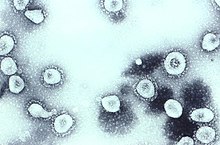| Human coronavirus OC43 | |
|---|---|

| |
| Transmission electron micrograph of human coronavirus OC43 | |
| Virus classification | |
| (unranked): | Virus |
| Realm: | Riboviria |
| Kingdom: | Orthornavirae |
| Phylum: | Pisuviricota |
| Class: | Pisoniviricetes |
| Order: | Nidovirales |
| Family: | Coronaviridae |
| Genus: | Betacoronavirus |
| Subgenus: | Embecovirus |
| Species: | |
| Virus: | Human coronavirus OC43
|
Human coronavirus OC43[1] (HCoV-OC43) is a member of the species Betacoronavirus 1, which infects humans and cattle.[2][3] The infecting coronavirus is an enveloped, positive-sense, single-stranded RNA virus that enters its host cell by binding to the N-acetyl-9-O-acetylneuraminic acid receptor.[4] OC43 is one of seven coronaviruses known to infect humans. It is one of the viruses responsible for the common cold[5][6] and may have been responsible for the 1889–1890 pandemic.[7] It has, like other coronaviruses from genus Betacoronavirus, subgenus Embecovirus, an additional shorter spike protein called hemagglutinin-esterase (HE).[8][2]
- ^ Lee, Paul (2007). Molecular epidemiology of human coronavirus OC43 in Hong Kong (Thesis). The University of Hong Kong Libraries. doi:10.5353/th_b4501128 (inactive 2024-04-12). hdl:10722/131538.
{{cite thesis}}: CS1 maint: DOI inactive as of April 2024 (link) - ^ a b "Taxonomy browser (Betacoronavirus 1)". www.ncbi.nlm.nih.gov. Retrieved 2020-02-29.
- ^ Lim, Yvonne Xinyi; Ng, Yan Ling; Tam, James P.; Liu, Ding Xiang (2016-07-25). "Human Coronaviruses: A Review of Virus–Host Interactions". Diseases. 4 (3): 26. doi:10.3390/diseases4030026. PMC 5456285. PMID 28933406.
See Table 1.
- ^ Li, Fang (2016-09-29). "Structure, Function, and Evolution of Coronavirus Spike Proteins". Annual Review of Virology. 3 (1): 237–261. doi:10.1146/annurev-virology-110615-042301. PMC 5457962. PMID 27578435.
BCoV S1-NTD does not recognize galactose as galectins do. Instead, it recognizes 5-N-acetyl-9-O-acetylneuraminic acid (Neu5,9Ac2) (30, 43). The same sugar receptor is also recognized by human coronavirus OC43 (43, 99). OC43 and BCoV are closely related genetically, and OC43 might have resulted from zoonotic spillover of BCoV (100, 101).
- ^ Lau, Susanna K. P.; Lee, Paul; Tsang, Alan K. L.; Yip, Cyril C. Y.; Tse, Herman; Lee, Rodney A.; So, Lok-Yee; Lau, Y.-L.; Chan, Kwok-Hung; Woo, Patrick C. Y.; Yuen, Kwok-Yung (2011). "Molecular Epidemiology of Human Coronavirus OC43 Reveals Evolution of Different Genotypes over Time and Recent Emergence of a Novel Genotype due to Natural Recombination". Journal of Virology. 85 (21): 11325–37. doi:10.1128/JVI.05512-11. PMC 3194943. PMID 21849456.
- ^ Gaunt, E.R.; Hardie, A.; Claas, E.C.J.; Simmonds, P.; Templeton, K.E. (2010). "Epidemiology and clinical presentations of the four human coronaviruses 229E, HKU1, NL63, and OC43 detected over 3 years using a novel multiplex real-time PCR method". J Clin Microbiol. 48 (8): 2940–7. doi:10.1128/JCM.00636-10. PMC 2916580. PMID 20554810.
- ^ Brüssow, Harald; Brüssow, Lütz (13 July 2021). "Clinical evidence that the pandemic from 1889 to 1891 commonly called the Russian flu might have been an earlier coronavirus pandemic". Microbial Biotechnology. 14 (5): 1860–1870. doi:10.1111/1751-7915.13889. PMC 8441924. PMID 34254725.
- ^ Woo, Patrick C. Y.; Huang, Yi; Lau, Susanna K. P.; Yuen, Kwok-Yung (2010-08-24). "Coronavirus Genomics and Bioinformatics Analysis". Viruses. 2 (8): 1804–20. doi:10.3390/v2081803. PMC 3185738. PMID 21994708.
In all members of Betacoronavirus subgroup A, a haemagglutinin esterase (HE) gene, which encodes a glycoprotein with neuraminate O-acetyl-esterase activity and the active site FGDS, is present downstream to ORF1ab and upstream to S gene (Figure 1).